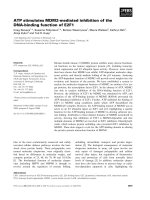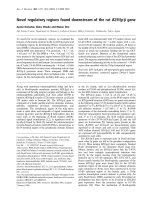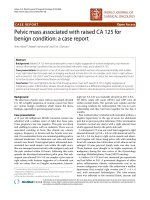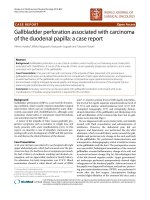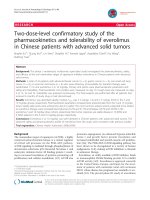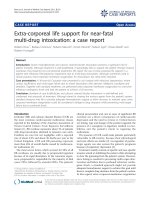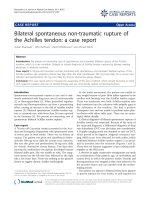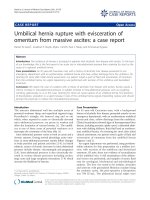Báo cáo y học: " Breast conserving surgery with preservation of the nipple-areola complex as a feasible and safe approach in male breast cancer: a case report" pptx
Bạn đang xem bản rút gọn của tài liệu. Xem và tải ngay bản đầy đủ của tài liệu tại đây (217.84 KB, 3 trang )
BioMed Central
Page 1 of 3
(page number not for citation purposes)
Journal of Medical Case Reports
Open Access
Case report
Breast conserving surgery with preservation of the nipple-areola
complex as a feasible and safe approach in male breast cancer: a
case report
Sophocles Lanitis*, George Filippakis
†
, Ragheed Al Mufti
†
and
Dimitri J Hadjiminas
†
Address: Breast Care Unit, Mary Stanford Wing 5th Floor, St Mary's NHS Trust, Praed Street, London W2 1NY, UK
Email: Sophocles Lanitis* - ; George Filippakis - ; Ragheed Al Mufti - ;
Dimitri J Hadjiminas -
* Corresponding author †Equal contributors
Abstract
Introduction: Breast cancer in men is rare. The evidence about treatment has been derived from
data on the management of the disease in women. The usual treatment is for male patients to
undergo modified radical mastectomy. There is insufficient experience of breast conserving surgery
with preservation of the nipple. The management of patients who demand such an approach for
personal reasons remains a challenge for both the surgeon and oncologist.
Case presentation: A 50-year-old man with a breast cancer was successfully managed with
breast conserving surgery with nipple preservation combined with axillary clearance and
postoperative radiotherapy, chemotherapy and hormone treatment. Since there are no similar
cases in the literature, we discuss the feasibility, safety and possible indications of such an approach.
Conclusion: Despite the limited indications and evidence about the safety and efficacy of breast
conserving surgery with nipple preservation in men with breast cancer, it is a feasible approach if
other options are declined by the patient. More studies are necessary to reach firm conclusions
about the safety of such an approach.
Introduction
Male breast cancer (MBC) is a rare disease and accounts
for less than 1% of breast cancers but incidence seems to
be increasing [1-6]. Owing to the small number of cases,
management of MBC is based on evidence derived from
data analysis of female breast cancer (FBC) patients and
on retrospective studies of a limited number of MBC
patients [2,3,5]. There is little experience of breast con-
serving surgery (BCS) with nipple preservation, as usually
there is no interest for the treatment from either the sur-
geon or patient. Therefore, management of those patients
who demand such an approach remains a challenge for
the treating physicians.
Case presentation
A 50-year-old man was referred to the breast unit present-
ing with a month's history of a suspicious lump in his left
breast. He had no family history of cancer. From his med-
ical history, the only remarkable finding was hepatitis B
30 years previously and genital herpes for which he was
taking Acyclovir. He had a history of smoking (30 packs
per year).
Published: 28 April 2008
Journal of Medical Case Reports 2008, 2:126 doi:10.1186/1752-1947-2-126
Received: 14 September 2007
Accepted: 28 April 2008
This article is available from: />© 2008 Lanitis et al; licensee BioMed Central Ltd.
This is an Open Access article distributed under the terms of the Creative Commons Attribution License ( />),
which permits unrestricted use, distribution, and reproduction in any medium, provided the original work is properly cited.
Journal of Medical Case Reports 2008, 2:126 />Page 2 of 3
(page number not for citation purposes)
Clinically, he had a lump centrally in the left breast, at a 6
o'clock position, with skin tethering and mild inversion of
the nipple. Ultrasound (US) and a mammogram demon-
strated a 1 cm suspicious lesion, which was found to be
cancer on both fine needle aspiration (FNA) and core
biopsy. The tumour was a grade 2 invasive ductal carci-
noma (IDC). Investigations did not show any distant
metastases. The patient was offered modified radical mas-
tectomy and sentinel node biopsy (SNB). The patient
declined any operation that would not preserve the nipple
and insisted on having BCS. After discussion with the
oncologists and patient about the risk of recurrence, we
proceeded with BCS with nipple preservation and SNB.
The sentinel node was involved and level III axillary clear-
ance was performed. Overall, one out of nine dissected
lymph nodes was positive. Our well-established protocols
for wide local excisions rely on 5 mm pathological clear
margins rather than negative margins [7]. Therefore, we
do not use frozen sections to assess the surgical margins.
The specimen weighed 19 g and included a 0.7 × 0.7 × 1
cm grade 2 IDC with an intermediate grade ductal carci-
noma in situ (DCIS), comprising 5% of the tumour mass.
The tumour was positive for oestrogen (ER) and proges-
terone receptors (PgR). The DCIS was present 0.2 cm from
the superficial margin and all other margins were more
than 0.8 cm.
The patient had four cycles of chemotherapy (Doxoru-
bicin 100 mg and Cyclophosphamide 1000 mg) and
adjuvant chest wall radiotherapy (50 gray in 25 fractions),
which he tolerated well. He was commenced on
Tamoxifen 20 mg once a day for 5 years and then switched
to Letrozole 2.5 mg. Repeated followup clinical examina-
tions, mammograms, breast US, bone scans and liver US
showed no evidence of disease. Eight years after the oper-
ation, the mammogram showed microcalcifications in the
ipsilateral breast and he underwent diagnostic biopsy of
the area, which showed fibrofatty tissue with focal stromal
calcifications without features of malignancy.
Discussion
MBC behaves in a way similar to FBC in postmenopausal
women [6]. Unlike FBC, there is only one peak at 67–71
years of age [2,4,6]. Family history, genetic factors (for
example, BRCA gene carriers, AR and CYP17 gene muta-
tion, Klinefelter syndrome, Cowden syndrome), exoge-
nous oestrogen administration and testicular anomalies
are among the risk factors [1-4,6], while radiation, obesity
and alcohol use are proposed but not widely accepted as
risk factors [2,3,6]. There is no proven association
between gynaecomastia and MBC [4,6]. Histologically,
more than 85% of tumours are of the invasive ductal type
[4,6]. Furthermore, over 90% of MBC express ER while
81% express PgR [5,8]. C-erb-B2 is less likely to be
expressed (about 5%) [2,3]. In men, 20% of the circulat-
ing estrogen is produced by the testis while about 80%
results from peripheral aromatisation of androgens [3,9].
The usual presentation is a palpable painless lump with or
without skin changes or nipple involvement but often
diagnosis is delayed [4,6]. The sensitivity of the mammo-
gram is reported to be 92% while specificity is 90% [6].
Breast US can be used to evaluate the tumour in the same
way as in women [2,4,10]. The prognosis depends on
tumour size, grade and extent of lymph node involvement
in the same way as in FBC [2,6]. Overall survival rate when
corrected for age is similar to that of FBC [2,6].
Traditionally patients with MBC undergo modified radi-
cal mastectomy with either SNB or axillary node clearance
(ANC) [2,3,6]. Despite the lack of firm evidence about the
safety of SNB, increasingly there is an acceptance of the
technique and its use [2,6]. Radiation therapy seems to
prevent local recurrence but it is not known whether it
adds anything to survival. The indications and dose
remain the same as in women [2,6]. Ablative techniques
aiming to control hormones, including orchidectomy,
adrenalectomy and hypophysectomy, have been used in
the past but had severe side effects, therefore medical hor-
mone manipulation has been tried [3,5]. For those
patients with hormone receptor-positive tumours, there is
a clear benefit from the use of Tamoxifen in both disease-
free and overall survival [3,5,6,11,12]. There is also a
proven effectiveness in those patients with metastatic dis-
ease and, therefore, Tamoxifen has been incorporated in
the treatment of MBC [2,3,5,11]. There is not sufficient
evidence for the use of aromatase inhibitors despite the
advances and proven efficacy in FBC and more studies
need to be done [2,3,5]. There are case reports supporting
a good response to Letrozole [3,13] even after failure of
Tamoxifen [3]. There is also some evidence about the
effectiveness of adjuvant chemotherapy. One prospective
study with a small number of patients (N = 24) showed a
survival benefit and other studies support this finding
[14]. Moreover, retrospective studies show reduction of
the risk of local recurrence [2,6,15].
Conclusion
Despite limited indications and lack of evidence about the
safety and efficacy of BCS with nipple preservation in men
with breast cancer, it is a feasible approach if other
options are declined by the patient. Apparently obtaining
good excision margins is the most important predictor of
local recurrences as it is for women.
With a case report of only one patient, it is impossible to
make any statement about the safety of such an approach
and more studies are necessary to reach firm conclusions.
Publish with BioMed Central and every
scientist can read your work free of charge
"BioMed Central will be the most significant development for
disseminating the results of biomedical research in our lifetime."
Sir Paul Nurse, Cancer Research UK
Your research papers will be:
available free of charge to the entire biomedical community
peer reviewed and published immediately upon acceptance
cited in PubMed and archived on PubMed Central
yours — you keep the copyright
Submit your manuscript here:
/>BioMedcentral
Journal of Medical Case Reports 2008, 2:126 />Page 3 of 3
(page number not for citation purposes)
Abbreviations
ANC: axillary node clearance; BCS: breast conserving sur-
gery; DCIS: ductal carcinoma in situ; FBC: female breast
cancer; FNA: fine needle aspiration; IDC: invasive ductal
carcinoma; MBC: male breast cancer; SNB: sentinel node
biopsy; US: ultrasound.
Competing interests
The authors declare that they have no competing interests.
Authors' contributions
SL and GF collected the data and reviewed the literature
and case notes and was involved in followup appoint-
ments. Furthermore, SL was involved in the active fol-
lowup and workup of the patient. SL wrote the paper with
the assistance of GF. RAM reviewed and edited the initial
manuscript. DJH performed the initial operation, and
organised the primary management plan of the patient.
He supervised the writing and editing of the paper. All the
authors have read and approved the final version of the
manuscript.
Consent
Written informed consent was obtained from the patient
for publication of this case report and any accompanying
images. A copy of the written consent is available for
review by the Editor-in-Chief of this journal.
Acknowledgements
We thank St Mary's Breast Care Unit for secretarial support and Charlotte
Garcia from St Mary's radiology department for the imaging supply.
References
1. Weiss JR, Moysich KB, Swede H: Epidemiology of male breast
cancer. Cancer Epidemiol Biomarkers Prev 2005, 14:20-26.
2. Giordano SH: A review of the diagnosis and management of
male breast cancer. Oncologist 2005, 10:471-479.
3. Zabolotny BP, Zalai CV, Meterissian SH: Successful use of letro-
zole in male breast cancer: a case report and review of hor-
monal therapy for male breast cancer. J Surg Oncol 2005,
90:26-30.
4. Chen L, Chantra PK, Larsen LH, Barton P, Rohitopakarn M, Zhu EQ,
Bassett LW: Imaging characteristics of malignant lesions of
the male breast. Radiographics 2006, 26:993-1006.
5. Nahleh ZA: Hormonal therapy for male breast cancer: A dif-
ferent approach for a different disease. Cancer Treat Rev 2006,
32:101-105.
6. Fentiman IS, Fourquet A, Hortobagyi GN: Male breast cancer. Lan-
cet 2006, 367:595-604.
7. Sibbering DM, Galea MH, Morgan DA, Elston CW, Ellis IO, Robertson
JF, Blamey RW: Safe selection criteria for breast conservation
without radical excision in primary operable invasive breast
cancer. Eur J Cancer 1995, 31A:2191-2195.
8. Giordano SH, Cohen DS, Buzdar AU, Perkins G, Hortobagyi GN:
Breast carcinoma in men: a population-based study. Cancer
2004, 101:51-57.
9. Griffin J, Wilson J: Disorders of the testis and the male repro-
ductive system. In Williams Textbook of Endocrinology 10th edition.
Edited by: Larsen P, Kronenberg H, Melmed S, Polonsky K. Philadel-
phia: Saunders; 2003:709-769.
10. Evans GF, Anthony T, Turnage RH, Schumpert TD, Levy KR,
Amirkhan RH, Campbell TJ, Lopez J, Appelbaum AH: The diagnos-
tic accuracy of mammography in the evaluation of male
breast disease. Am J Surg 2001, 181:96-100.
11. Ribeiro G, Swindell R: Adjuvant tamoxifen for male breast can-
cer (MBC). Br J Cancer 1992, 65:252-254.
12. Goss P, Reid C, Pintilie M: Male breast carcinoma: a review of
229 patients who presented to the Princes Margaret Hospi-
tal during 40 years: 1955–1996. Cancer 1999, 85:629-639.
13. Italiano A, Largillier R, Marcy PY, Foa C, Ferrero JM, Hartmann MT,
Namer M: Complete remission obtained with letrozole in a
man with metastatic breast cancer. Rev Med Interne 2004,
25:323-324.
14. Bagley CS, Wesley MN, Young RC: Adjuvant chemotherapy in
males with cancer of the breast. Am J Clin Oncol 1987, 10:55-60.
15. Patel HZ, Buzdar AU, Hortobagyi GN: Role of adjuvant chemo-
therapy in male breast cancer. Cancer 1989, 64:1583-1585.
